


| we turn coffee into puzzles |
Published and custom puzzles
|
Plus Magazine Sudoku
Each row, column, and jigsaw region must include exactly the letters you find in the words "PLUS MAGAZINE", including repetitions. This means that each row, column, and region will contain the letter "A" twice.
|
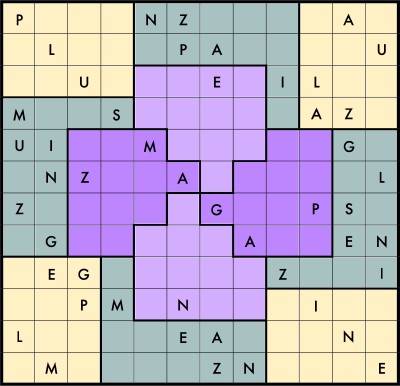
|
|
Euler Sudoku
The symbols e, π, i, 0, 1, f, Σ, φ, and γ must each appear exactly once in each row, column, and 3x3 block.
|
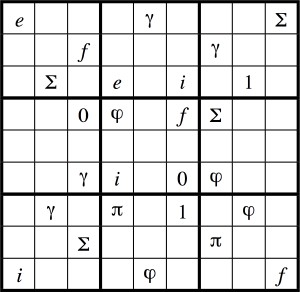
|
|
Classic Sudoku
The numbers 1--9 must each appear exactly once in each row, column, and block.
|
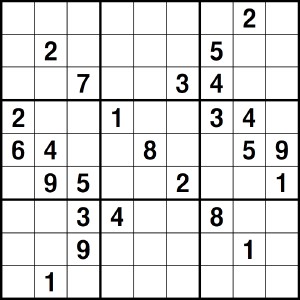
|
|
Sudoku X
The numbers 1--9 must each appear exactly once in each row, column, block, and main diagonal.
|
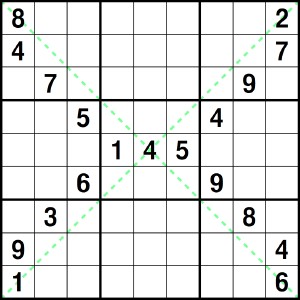
|
|
Four Squares
The numbers 1--9 must each appear exactly once in each row, column, block, and shaded square region.
|
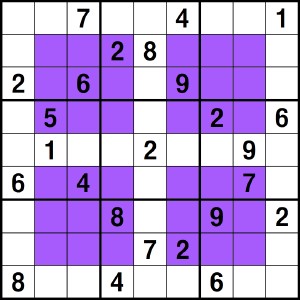
|
|
Pyramids
The numbers 1--9 must each appear exactly once in each row, column, block, and pyramid.
|
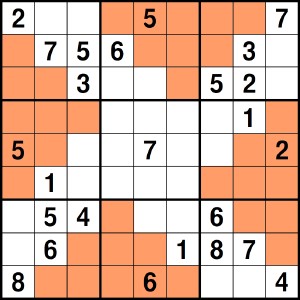
|
|
Magic Squares
The numbers 1--9 must each appear exactly once in each row, column, and block. In addition, each of the shaded squares is a (semi)-magic square, meaning that the minirows and minicolumns of each shaded square sum to the same amount.
|
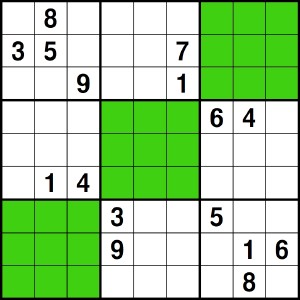
|
|
Positions
The numbers 1--9 must each appear exactly once in each row, column, block, and shaded region. Notice that the shaded regions are not connected; for example, the red region consists of all nine of the red cells in the puzzle.
|
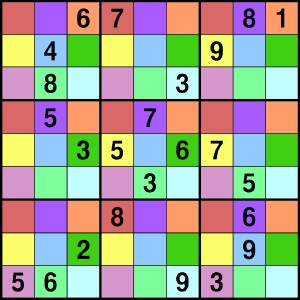
|
|
Greater Than
Each of the numbers 1-9 must each appear exactly once in each row, column, and block. In addition, adjacent cells must obey any 'greater than' (>) or 'less than' (<) symbol that appears on their dividing line. Note that this puzzle has no starting clues given; the greater than symbols are enough to determine a unique solution without any initial conditions at all! As an aid in solving, some cells have been shaded. Cells with a lower value than all their neighbors are blue; cells with a higher value than all their neighbors are red.
|
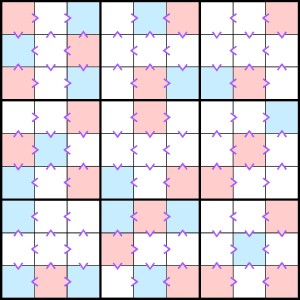
|
|
Classic Sudoku
The numbers 1--9 must each appear exactly once in each row, column, and block.
|
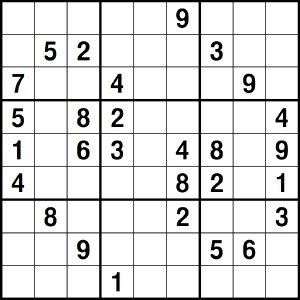
|
|
Classic Sudoku
The numbers 1--9 must each appear exactly once in each row, column, and block.
|
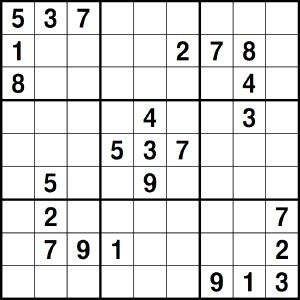
|
|
Classic Sudoku
The numbers 1--9 must each appear exactly once in each row, column, and block.
|
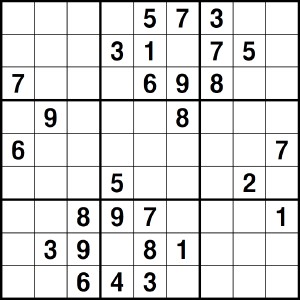
|
|
Sudoku X
The numbers 1--9 must each appear exactly once in each row, column, block, and main diagonal.
|
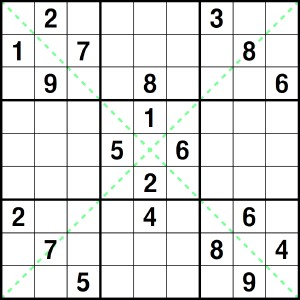
|
|
Jigsaw
The numbers 1--9 must each appear exactly once in each row, column, and jigsaw region.
|
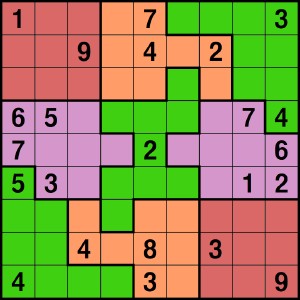
|
|
Even/Odd Sudoku
The numbers 1--9 must each appear exactly once in each row, column, and block In addition, green cells can only contain odd numbers, and blue cells can only contain even numbers.
|
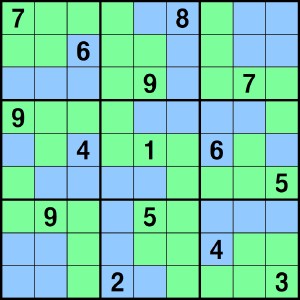
|
|
Greater Than Sudoku
Each of the numbers 1-9 must each appear exactly once in each row, column, and block. In addition, adjacent cells must obey any 'greater than' (>) or 'less than' (<) symbol that appears on their dividing line. Note that this puzzle has no starting clues given; the greater than symbols are enough to determine a unique solution without any initial conditions at all! As an aid in solving, some cells have been shaded. Cells with a lower value than all their neighbors are blue; cells with a higher value than all their neighbors are red.
|
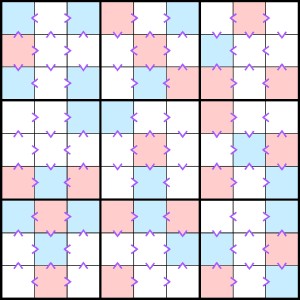
|
|
Clock Sudoku
The numbers 1--12 must each appear exactly once in each ring, each pair of adjacent same-colored wedges, and each pair of opposite wedges.
|
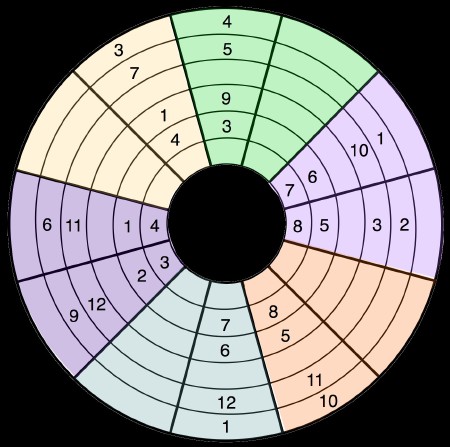
|
|
Minimum Sudoku
The numbers 1--9 must each appear exactly once in each row, column, and block. This is an example of an 18-clue puzzle! 18 clues is the minimum known number of clues in a symmetric Sudoku puzzle that will determine a unique solution.
|
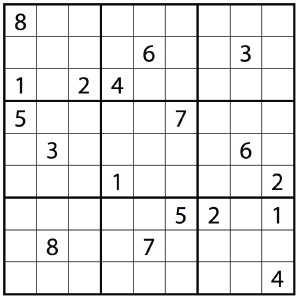
|
|
Sudoku Brothers
For each puzzle, the numbers 1--9 must each appear exactly once in each row, column, and block. What is interesting here is that both of these puzzles have the same solution. (Obviously you shouldn't look at one while you play the other, or you'll have additional information!)
|
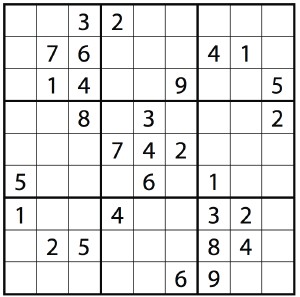
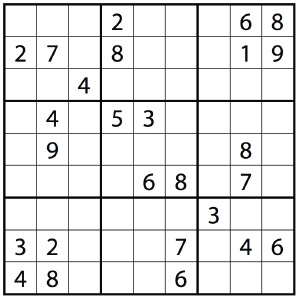
|
|
Snowflake
The numbers 1--9 must each appear exactly once in each row, column, and block, and no numbers are repeated in any marked diagonal.
|
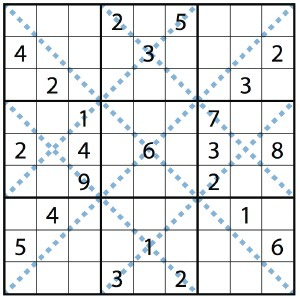
|
|
Pyramids
The numbers 1--9 must each appear exactly once in each row, column, block, and pyramid.
|
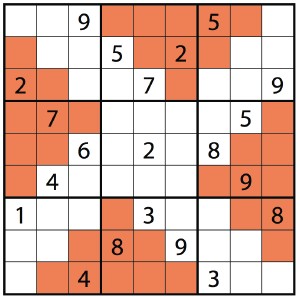
|
|
Jigsaw
The numbers 1--9 must each appear exactly once in each row, column, block, and jigsaw region.
|
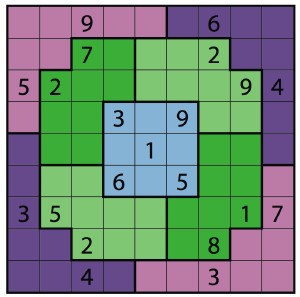
|
|
Rainbow Wrap Up
The numbers 1--9 must each appear exactly once in each row, column, block, and colored region. Notice that the colored regions wrap around the board; for example, the green region consists of all nine of the green cells in the puzzle.
|
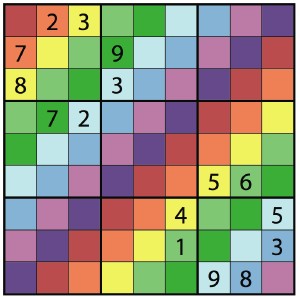
|
|
Worms
The numbers 1--9 must each appear exactly once in each row, column, and block. In addition, each worm should consist of an increasing sequence of numbers from tail to head. For example, a worm of length four could contain the numbers 2, 5, 6, and 8, in that order from tail to head. You have to figure out the direction of each worm.
|
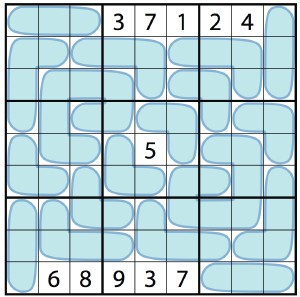
|
|
Mystery Sums
The numbers 1--9 must each appear exactly once in each row, column, and block. In addition, all shaded regions of a given color add to the same sum; for example, if one red shaded region has entries that sum to 21, then all red shaded regions in that puzzle sum to 21. The sums are not given; you must determine them yourself.
|
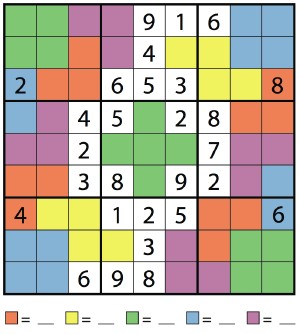
|
|
James Madison Sudoku
Fill in the grid so that each row, column, and jigsaw region contains exactly the letters in "JAMES MADISON". Note that the letters 'A', 'M', and 'S' will each appear twice in each row, column, and region.
|
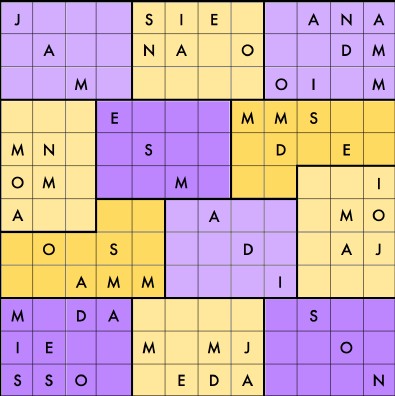
|
|
Greater Than Sudoku
Each of the numbers 1-9 must each appear exactly once in each row, column, and block. In addition, adjacent cells must obey any 'greater than' (>) or 'less than' (<) symbol that appears on their dividing line. Note that this puzzle has no starting clues given; the greater than symbols are enough to determine a unique solution without any initial conditions at all! As an aid in solving, some cells have been shaded. Cells with a lower value than all their neighbors are blue; cells with a higher value than all their neighbors are red.
|
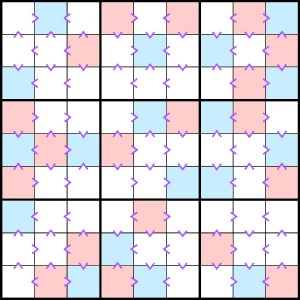
|
|
Worms Sudoku
The numbers 1--9 must each appear exactly once in each row, column, and block. In addition, each worm should consist of an increasing sequence of numbers from tail to head. For example, a worm of length four could contain the numbers 2, 5, 6, and 8, in that order from tail to head. You have to figure out for each worm which end is the head and which is the tail.
|
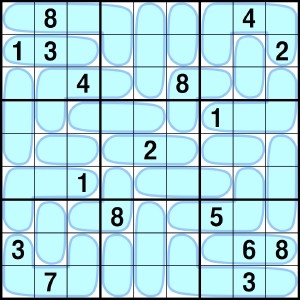
|
|
MathFest 2007 Sudoku
Fill in the grid so that each row, column, and jigsaw region contains exactly the letters in "MATHFEST 2007". Note that 'T' and '0' will each appear twice in each row, column, and region.
|
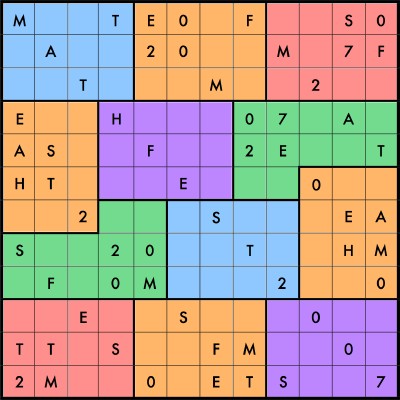
|
|
Pyramids
The numbers 1--9 must each appear exactly once in each row, column, block, and pyramid. This puzzle has difficulty level 1 of 3.
|
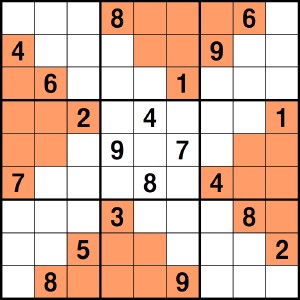
|
|
Jigsaw
The numbers 1--9 must each appear exactly once in each row, column, and jigsaw region. This puzzle has difficulty level 2 of 3.
|
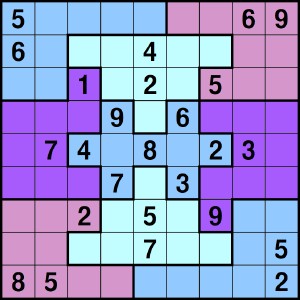
|
|
Worms
The numbers 1--9 must each appear exactly once in each row, column, and block. In addition, each worm should consist of an increasing sequence of numbers from tail to head. For example, a worm of length four could contain the numbers 2, 5, 6, and 8, in that order from tail to head. Green worms have their heads marked with eyes, but blue worms don't; you have to figure out their direction. This puzzle has difficulty level 2 of 3.
|
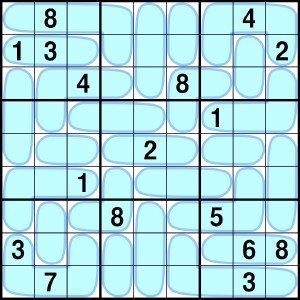
|
|
Harry Potter Sudoku
Fill in the grid so that each row, column, and region contains each of the letters in HARRY POTTER. Note that the letter 'T' will appear twice and the letter 'R' will appear thrice in each row, column, and region.
|
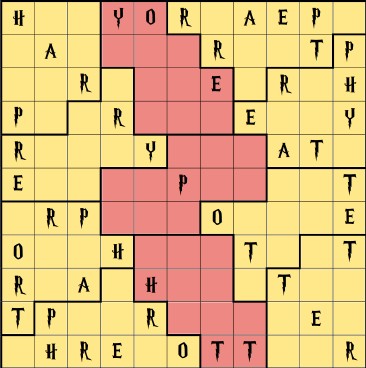
|
|
Mystery Sum Sudoku
The numbers 1--9 must each appear exactly once in each row, column, and block. In addition, all shaded regions of a given color add to the same sum; for example, if one red shaded region has entries that sum to 21, then all red shaded regions in that puzzle sum to 21. The sums are not given; you must determine them yourself.
|
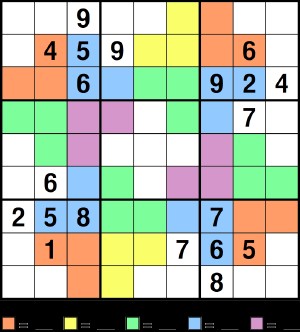
|
|
Greater Than Sudoku
Each of the numbers 1-9 must each appear exactly once in each row, column, and block. In addition, adjacent cells must obey any 'greater than' (>) or 'less than' (<) symbol that appears on their dividing line. Note that this puzzle has no starting clues given; the greater than symbols are enough to determine a unique solution without any initial conditions at all! As an aid in solving, some cells have been shaded. Cells with a lower value than all their neighbors are blue; cells with a higher value than all their neighbors are red.
|
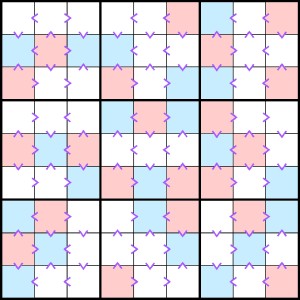
|
|
MATC Sudoku
Fill in the grid so that each row, column, and jigsaw region contains exactly the letters in "MATC SUDOKU". Note that the letter 'U' must each appear twice in each row, column, and region.
|
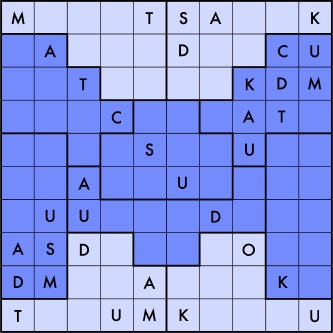
|
|
Carriage House Sudoku
Fill in the grid so that each row, column, and jigsaw region contains exactly the letters in "CARRIAGE HOUSE". Note that the letters 'A', 'R' and 'E' will each appear twice in each row, column, and region.
|
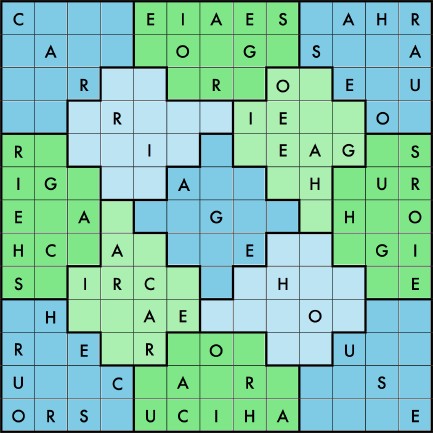
|
|
MUDDoku
Fill in the grid so that each row, column, and jigsaw region contains exactly the letters in "HARVEY MUDD". Note that the letter 'D' will appear twice in each row, column, and region.
|
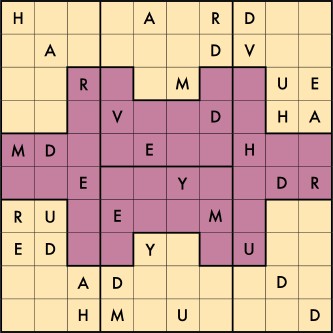
|
|
Fool's Feast Sudoku
Fill in the grid so that each row, column, and jigsaw region contains exactly the letters in "FOOL'S FEAST". Note that the letters 'F', 'S', and 'O' must each appear twice in each row, column, and region.
|
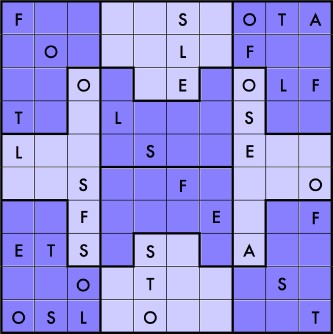
|
|
Sam Houston Sudoku
Fill in the grid so that each row, column, and jigsaw region contains exactly the letters in "SAM HOUSTON". Note that the letters 'S' and 'O' must each appear twice in each row, column, and region.
|
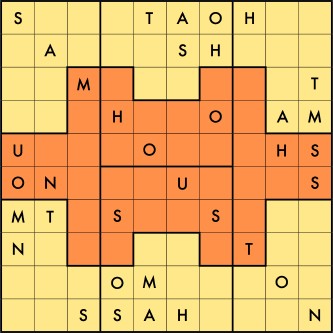
|
|
Jumble Pi Sudoku
The numbers 1--9 must each appear exactly once in each row, column, block, and color. Note that each colored region is disconnected; for example, the red region is the set of all nine of the red cells.
|
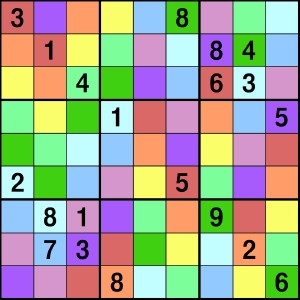
|
|
Clock Sudoku
The numbers 1--12 must each appear exactly once in each ring, each pair of adjacent same-colored wedges, and each pair of opposite wedges.
|
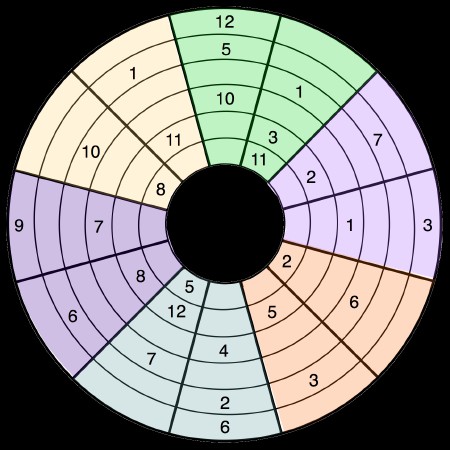
|
|
Worms Sudoku
The numbers 1--9 must each appear exactly once in each row, column, and block. In addition, each worm should consist of an increasing sequence of numbers from tail to head. For example, a worm of length four could contain the numbers 2, 5, 6, and 8, in that order from tail to head. Green worms have their heads marked with eyes, but blue worms don't; you have to figure out their direction.
|
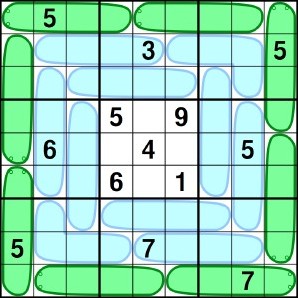
|
|
SUMS Sudoku
The numbers 1--9 must each appear exactly once in each row, column, and block. In addition, all shaded regions of a given color add to the same sum; for example, if one red shaded region has entries that sum to 21, then all red shaded regions in that puzzle sum to 21. The sums are not given; you must determine them yourself.
|
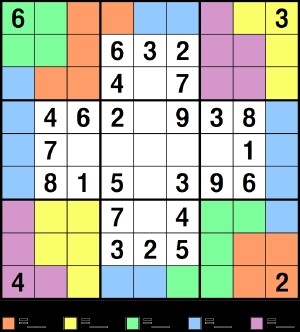
|
|
Pentominoku
The ten numbers 0--9 must each appear exactly once in each row and column, with no repeated entries in any pentomino region. In addition, there are exactly two pentominos that contain only the numbers 1--5, and exactly two pentominos that contain only even numbers.
|
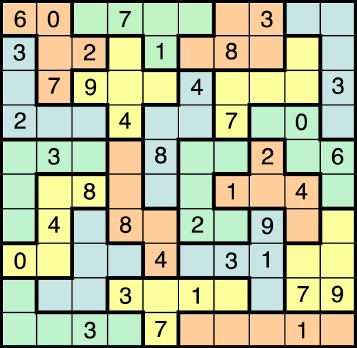
|
|
Costas Array Sudoku
The numbers 1--9 must each appear exactly once in each row, column, block, and color. Note that each colored region is disconnected; for example, the red region is the set of all nine of the red cells.
|
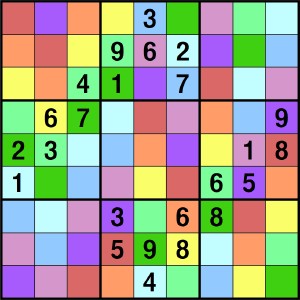
|
|
Samurai X
Five interlocking Sudoku X puzzles; the numbers 1--9 must each appear exactly once in each row, column, block, and main diagonal of each of the five 9x9 grids.
|
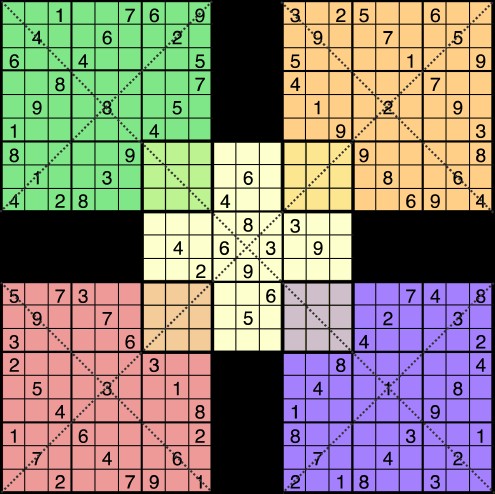
|
|
JMU SUMS 05 Sudoku
Every row, column, and block must contain exactly the letters in 'JMU SUMS 05'. Notice that the letters 'M', 'U', and 'S' will each appear twice in each region.
|
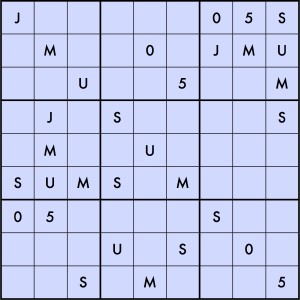
|